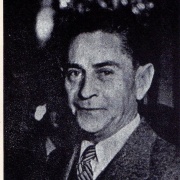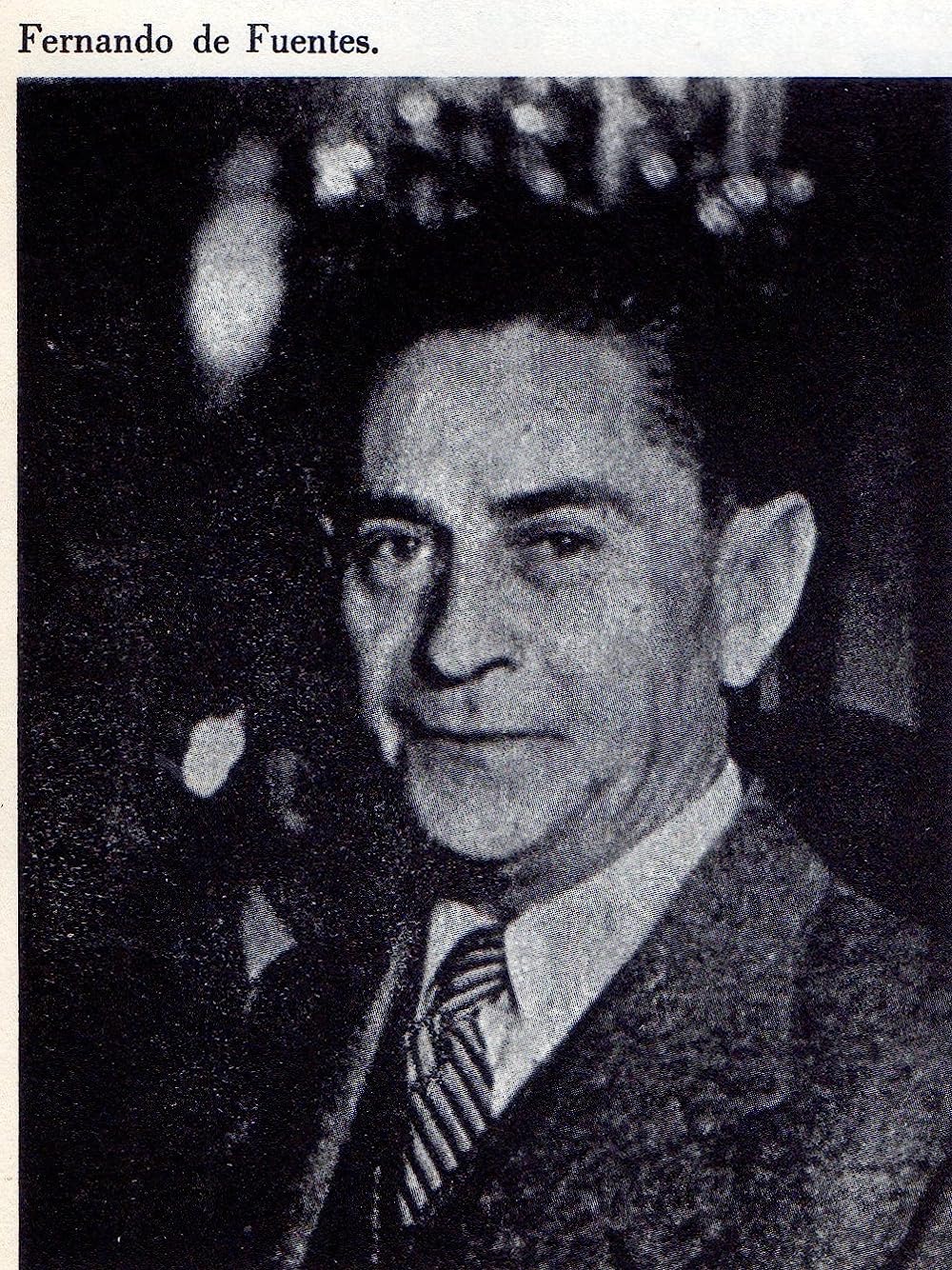 Product Product Link Link |
|
 Director of two classic films of Mexican Cinema, Compadre Mendoza, El (1933) and ?V��monos con Pancho Villa! (1935), De Fuentes began his career as second assistant director in Santa (1931), the first "talkie" produced in Mexico. His technical abilities promoted him to direct An��nimo, El (1932). De Fuentes is considered a pioneer in Mexican movies and a truly gifted director who combined superb technical abilities with a extraordinary sense for visu al narrative. His best films are those made on the early years of Mexican film industry. He "invented" a genre: the Mexican comedy (comedia ranchera) with All�� en el Rancho Grande (1936), the first Mexican film with great success in foreign markets -a sort of musical Como Agua Para Chocolate (1992) of the 30s. He discovered Gabriel Figueroa and pioneered genres such as horror, melodrama and historical. De Fuentes was the first Mexican director who made a film in color: Asi se Quiere en Jalisco (1942). He also was the first to make a film in coproduction with another country: Jalisco Canta en Sevilla (1948), coproduced with Spain.Born in Veracruz; Mexico on December 13 1894, son of Fernando De Fuentes and Emelina Carrau de De Fuentes. He studied Philosophy at Tulane University in New Orleans On his return to Mexico he worked as executive assistant of Venustiano Carranza during the Mexican Revolution. After his marriage in 1919, he moved to Washington D.C., and worked at the Mexican Embassy. Back in Mexico, he wrote poetry and undertook journalism as a hobby, and worked in the Film Industry in exhibition. In 1932 he made his first film, "El An��nimo", and in the same year "Una Vida por Otra", in 1933 "El Prisionero 13", "La Calandria", "El Tigre de Yautepec" and "El Compadre Mendoza", considered one of his masterpieces, in the Mexican Revolution Trilogy, ("El Compadre Mendoza", "Vamonos con Pancho Villa" and "El Prisionero 13").In 1934 he directed "El Fantasma del Convento", and "Cruz Diablo". In 1935 he made "Vamonos con Pancho Villa", and "La Familia Dressel", in 1936 "Las Mujeres Mandan" and one of the greatest hits in the history of the Mexican cinema, "Alla en el Rancho Grande" - a film that developed a complete new genre the "comedia ranchera", with this film he was awarded the "Medalla al M��rito Cinematogr��fico" by the Mexican President General L��zaro C��rdenas. This film also won first place at the "Venice Film Festival" in 1938. It was the first International award won by a Mexican film.Described as "the Mexican John Ford" (New York Times), Fernando de Fuentes was by far the most talented filmmaker of early Mexican sound cinema. This tragic trilogy set during the Mexican Revolution was possibly his greatest achievement. Prisoner 13 (1933, 76 mins.) concerns a son who pays for his father's faults and a desperate mother who tries at all costs to save her son's life. El Compadre Mendoza (1933, 85 mins.) examines the corrupted ideals of the Revolution by way of an opportunistic landowner, who must choose between remaining loyal to a general in Zapata's army (and facing financial ruin) or saving his own skin. Lastly, Fuentes' sweeping epic Let's Go with Pancho Villa (1936, 92 mins.) follows the adventures of six young men who leave their rural homes to join Pancho Villa's army, enduring hardship, loss, and disillusionment over the Revolution in the process. Shot by Gabriel Figueroa (The Fugitive), one of the world's most gifted black and white cinematographers.His filmography covers almost all the different genres from drama, comedy, horror, family, historical, to classics and documentaries Fernando De Fuentes died on July 4, 1958 in Mexico City. Director of two classic films of Mexican Cinema, Compadre Mendoza, El (1933) and ?V��monos con Pancho Villa! (1935), De Fuentes began his career as second assistant director in Santa (1931), the first "talkie" produced in Mexico. His technical abilities promoted him to direct An��nimo, El (1932). De Fuentes is considered a pioneer in Mexican movies and a truly gifted director who combined superb technical abilities with a extraordinary sense for visu al narrative. His best films are those made on the early years of Mexican film industry. He "invented" a genre: the Mexican comedy (comedia ranchera) with All�� en el Rancho Grande (1936), the first Mexican film with great success in foreign markets -a sort of musical Como Agua Para Chocolate (1992) of the 30s. He discovered Gabriel Figueroa and pioneered genres such as horror, melodrama and historical. De Fuentes was the first Mexican director who made a film in color: Asi se Quiere en Jalisco (1942). He also was the first to make a film in coproduction with another country: Jalisco Canta en Sevilla (1948), coproduced with Spain.Born in Veracruz; Mexico on December 13 1894, son of Fernando De Fuentes and Emelina Carrau de De Fuentes. He studied Philosophy at Tulane University in New Orleans On his return to Mexico he worked as executive assistant of Venustiano Carranza during the Mexican Revolution. After his marriage in 1919, he moved to Washington D.C., and worked at the Mexican Embassy. Back in Mexico, he wrote poetry and undertook journalism as a hobby, and worked in the Film Industry in exhibition. In 1932 he made his first film, "El An��nimo", and in the same year "Una Vida por Otra", in 1933 "El Prisionero 13", "La Calandria", "El Tigre de Yautepec" and "El Compadre Mendoza", considered one of his masterpieces, in the Mexican Revolution Trilogy, ("El Compadre Mendoza", "Vamonos con Pancho Villa" and "El Prisionero 13").In 1934 he directed "El Fantasma del Convento", and "Cruz Diablo". In 1935 he made "Vamonos con Pancho Villa", and "La Familia Dressel", in 1936 "Las Mujeres Mandan" and one of the greatest hits in the history of the Mexican cinema, "Alla en el Rancho Grande" - a film that developed a complete new genre the "comedia ranchera", with this film he was awarded the "Medalla al M��rito Cinematogr��fico" by the Mexican President General L��zaro C��rdenas. This film also won first place at the "Venice Film Festival" in 1938. It was the first International award won by a Mexican film.Described as "the Mexican John Ford" (New York Times), Fernando de Fuentes was by far the most talented filmmaker of early Mexican sound cinema. This tragic trilogy set during the Mexican Revolution was possibly his greatest achievement. Prisoner 13 (1933, 76 mins.) concerns a son who pays for his father's faults and a desperate mother who tries at all costs to save her son's life. El Compadre Mendoza (1933, 85 mins.) examines the corrupted ideals of the Revolution by way of an opportunistic landowner, who must choose between remaining loyal to a general in Zapata's army (and facing financial ruin) or saving his own skin. Lastly, Fuentes' sweeping epic Let's Go with Pancho Villa (1936, 92 mins.) follows the adventures of six young men who leave their rural homes to join Pancho Villa's army, enduring hardship, loss, and disillusionment over the Revolution in the process. Shot by Gabriel Figueroa (The Fugitive), one of the world's most gifted black and white cinematographers.His filmography covers almost all the different genres from drama, comedy, horror, family, historical, to classics and documentaries Fernando De Fuentes died on July 4, 1958 in Mexico City.

Bio:
Director of two classic films of Mexican Cinema, Compadre Mendoza, El (1933) and ?V��monos con Pancho Villa! (1935), De Fuentes began his career as second assistant director in Santa (1931), the first "talkie" produced in Mexico. His technical abilities promoted him to direct An��nimo, El (1932). De Fuentes is considered a pioneer in Mexican movies and a truly gifted director who combined superb technical abilities with a extraordinary sense for visu al narrative. His best films are those made on the early years of Mexican film industry. He "invented" a genre: the Mexican comedy (comedia ranchera) with All�� en el Rancho Grande (1936), the first Mexican film with great success in foreign markets -a sort of musical Como Agua Para Chocolate (1992) of the 30s. He discovered Gabriel Figueroa and pioneered genres such as horror, melodrama and historical. De Fuentes was the first Mexican director who made a film in color: Asi se Quiere en Jalisco (1942). He also was the first to make a film in coproduction with another country: Jalisco Canta en Sevilla (1948), coproduced with Spain.
Born in Veracruz; Mexico on December 13 1894, son of Fernando De Fuentes and Emelina Carrau de De Fuentes. He studied Philosophy at Tulane University in New Orleans On his return to Mexico he worked as executive assistant of Venustiano Carranza during the Mexican Revolution. After his marriage in 1919, he moved to Washington D.C., and worked at the Mexican Embassy. Back in Mexico, he wrote poetry and undertook journalism as a hobby, and worked in the Film Industry in exhibition. In 1932 he made his first film, "El An��nimo", and in the same year "Una Vida por Otra", in 1933 "El Prisionero 13", "La Calandria", "El Tigre de Yautepec" and "El Compadre Mendoza", considered one of his masterpieces, in the Mexican Revolution Trilogy, ("El Compadre Mendoza", "Vamonos con Pancho Villa" and "El Prisionero 13").In 1934 he directed "El Fantasma del Convento", and "Cruz Diablo". In 1935 he made "Vamonos con Pancho Villa", and "La Familia Dressel", in 1936 "Las Mujeres Mandan" and one of the greatest hits in the history of the Mexican cinema, "Alla en el Rancho Grande" - a film that developed a complete new genre the "comedia ranchera", with this film he was awarded the "Medalla al M��rito Cinematogr��fico" by the Mexican President General L��zaro C��rdenas. This film also won first place at the "Venice Film Festival" in 1938. It was the first International award won by a Mexican film.Described as "the Mexican John Ford" (New York Times), Fernando de Fuentes was by far the most talented filmmaker of early Mexican sound cinema. This tragic trilogy set during the Mexican Revolution was possibly his greatest achievement. Prisoner 13 (1933, 76 mins.) concerns a son who pays for his father's faults and a desperate mother who tries at all costs to save her son's life. El Compadre Mendoza (1933, 85 mins.) examines the corrupted ideals of the Revolution by way of an opportunistic landowner, who must choose between remaining loyal to a general in Zapata's army (and facing financial ruin) or saving his own skin. Lastly, Fuentes' sweeping epic Let's Go with Pancho Villa (1936, 92 mins.) follows the adventures of six young men who leave their rural homes to join Pancho Villa's army, enduring hardship, loss, and disillusionment over the Revolution in the process. Shot by Gabriel Figueroa (The Fugitive), one of the world's most gifted black and white cinematographers.His filmography covers almost all the different genres from drama, comedy, horror, family, historical, to classics and documentaries Fernando De Fuentes died on July 4, 1958 in Mexico City.
Tivia:
|
| Name: |
Fernando de Fuentes |
Type: |
Writer,Producer,Director (IMDB) |
| Area: |
All World |
Platform: |
IMDB |
| Category: |
|
Business scope: |
Writer,Producer,Director |
| Products for sale: |
Writer,Producer,Director |
| Last update: |
2024-07-02 03:40:24 |
Fernando de Fuentes profile
| Biography: |
Director of two classic films of Mexican Cinema, Compadre Mendoza, El (1933) and ?V��monos con Pancho Villa! (1935), De Fuentes began his career as second assistant director in Santa (1931), the first \"talkie\" produced in Mexico. His technical |
| Job title: |
Writer,Producer,Director |
| Spouse: |
Magdalena Reyes Moran (1919 - July 4, 1958) (his death, 2 children) |
|

